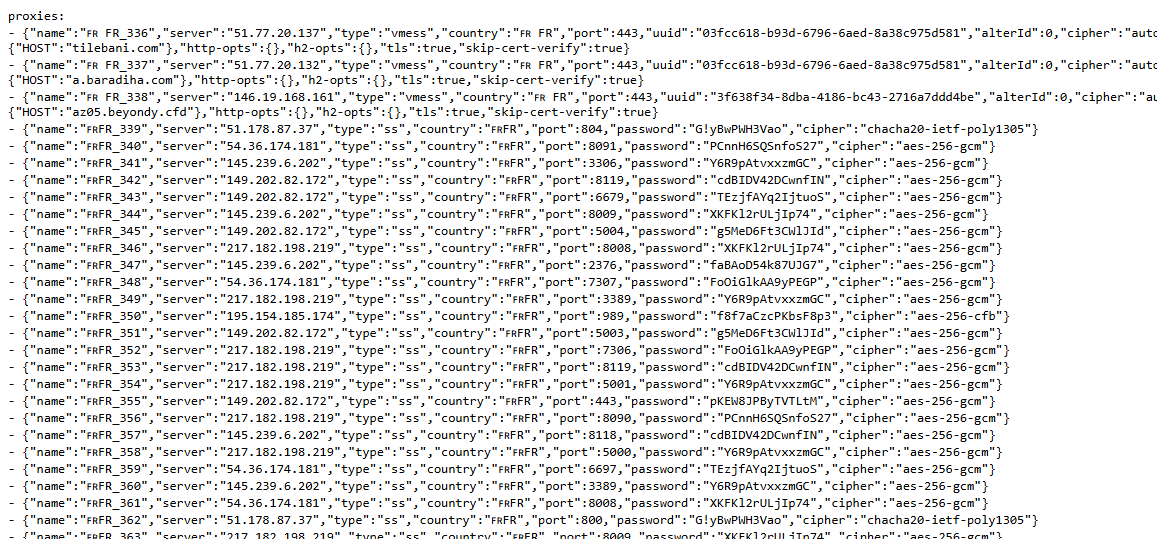Top Web Scraping Software in 2025
Discover top web scraping tools for 2025, comparing features, proxy integration, and scalability to optimize your data extraction efforts.
Post Time:2025-04-25
Learn how to safely and efficiently use inurl:clash/proxies to find proxy configurations for Clash. Step-by-step tips in this guide.
Clash is a popular proxy management tool for bypassing restrictions and enhancing online privacy. If you've ever searched for Clash proxy configurations, you may have come across the term "inurl:clash/proxies." This search operator can find Clash publicly available proxy files and configurations. In this guide, we'll explain how to use this search effectively and discuss safer options.

inurl:clash/proxies is a search operator that helps Google users find web pages containing the path "clash/proxies" in their URL. This means that when you use it, Google will show results containing this phrase, which often point to proxy configuration files for Clash.
These files typically come in YAML format (.yaml or .yml) and are used to manage proxy servers for various purposes, such as bypassing geo-restrictions or enhancing privacy. Using this search operator, users can easily find resources without sifting through irrelevant content.
There are three main scenarios where people use inurl:clash/proxies:
1. Finding Free Proxy Configurations
This is the main reason. Many users look for free proxy configurations to use with Clash. It's an easy way to access proxy servers without payment.
2. Accessing Pre-configured YAML Files for Clash
Users often want ready-to-use YAML files directly imported into their Clash application, saving time and effort.
3. Learning How to Set Up and Manage Proxies
Beginners may search it to find tutorials and guides on how to set up and manage proxies effectively.
However, it's important to exercise caution. Public proxies can be risky.
Open your web browser, navigate to Google, and type "inurl:clash/proxies" in the search bar.

This will provide you with a list of web pages that contain the specified URL structure.
After hitting "Enter," you’ll see various results. Look for URLs that lead to YAML configuration files or trusted sources. It’s crucial to assess the credibility of the websites. Avoid suspicious or unverified sites to minimize risks.

Once you find a reliable source, you can download the configuration file or copy its contents. Ensure the file is in YAML format (.yaml or .yml) Clash required.
To import the configuration file into Clash:
While using inurl:clash/proxies can help you find proxy configurations, there are inherent risks associated with public proxies:
Due to these risks, verify the source of any proxy configuration before using it.
1. Use Paid Proxy Services
One of the best ways to ensure security and reliability is paid proxy services. Choose providers offering faster and more secure services with guarantees of customer support and uptime.
2. Set Up Your Own Proxy
If you want complete control over your proxy setup, consider setting up your own proxy using tools like Shadowsocks, V2Ray, or Trojan. But this requires more technical knowledge.
3. Use Trusted Community Sources
Check forums like Reddit, GitHub repositories, or official Clash communities. These platforms often have vetted proxy files shared by users who have tested them, providing a safer alternative to anonymous public proxies.
Creating your own configuration file can be a great way to ensure trusted proxies. Here’s a simple example:

For Copy
proxies:
- name: "My SOCKS5 Proxy"
type: socks5
server: 123.45.67.89
port: 1080
username: your_username
password: your_password
proxy-groups:
- name: "Proxy Group"
type: select
proxies:
- "My SOCKS5 Proxy"
rules:
- DOMAIN-SUFFIX,google.com,Proxy Group
- GEOIP,CN,DIRECT
- MATCH,Proxy Group
In this example
proxies: Define the proxy server details.
proxy-groups: Create groups for easy selection of proxies.
rules: Set rules to determine how traffic should be routed.
For safety, consider investing in reputable paid proxy services for your specific requirements. You can enjoy a more secure and efficient internet experience with Clash or other tools. factors to consider when choosing proxies:
1. Purpose of Use
Determine what you need the proxy for:
2. Reliability and Speed
3. Anonymity and Security
4. Cost
Evaluate your budget. Free proxies may seem appealing but often come with risks. Paid proxies, especially residential ones, offer better performance and security.
5. Source Verification
Always verify. You can choose proxies that have been tested by community or forum users.
1. What is Clash?
Clash is a proxy management tool that supports multiple protocols, including SOCKS5, Shadowsocks, VMess, and more. It allows users to manage and route their internet traffic efficiently.
2. Is it safe to use public proxies?
Public proxies can be risky due to privacy and security concerns. If you need to use it, please always verify the source. If possible, opt for paid services for greater security.
3. Can I use 'inurl:clash/proxies' to find free proxies?
Yes, you can find free proxies using this search operator, be cautious about their reliability and safety.
The search operator inurl:clash/proxies is a convenient way to find proxy configurations for Clash, but users must exercise caution when using publicly available proxies. For a safer and more reliable experience, consider paid proxy services or creating your own configuration.
Look for a provider offering reliable proxies? Consider MacroProxy. We provide quality residential and datacenter proxies at reasonable prices. Free test before payment, so that you can ensure they satisfy your tasks without wasting your money. Register and contact us to get a free trial!
< Previous
Next >